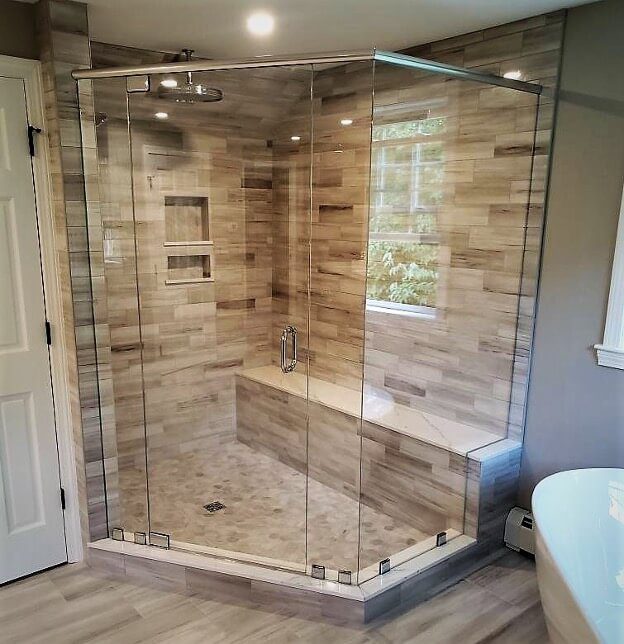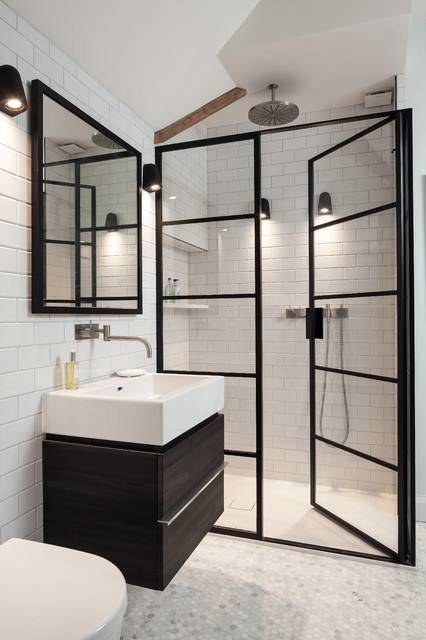They are making a number of good pointers relating to How to Install a Shower Enclosure as a whole in the article further down.

A successful shower installment needs cautious planning as well as a lot of work. In most cases, you will certainly require to do three types of jobs: framing wall surfaces, installing the plumbing, as well as finishing walls.
Prep work
First of all, you must choose the kind of shower that you want to set up. It is important to ascertain whether the chosen shower is capable of managing particular systems and can regulate a safe degree of water through the boiler. Most shower systems nowadays are developed to be adaptable to various water pressures (such as stored warm water and also cool keys).
It is also essential to consider the water pressure and the planning of the piping and also drain for the shower
Various Sorts Of Shower Units
- Push-on Mixer: The tube and spray parts of the push-on mixer shower unit can be linked to the bathroom faucet as per your demand, and the water temperature level can be readjusted through the faucets. Push-on mixers are cheap and also extremely easy to set up. Nevertheless, although the tube connection is straightforward, it is easily removed. In addition, it is troublesome to readjust the temperature level.
- Bath/Shower Mixer: The hose and also spray of this kind of shower are integrated with a bath mixer faucet, and also the temperature level can be changed with the bath faucets. It is a really affordable option and also no extra plumbing is included. Nonetheless, the bath/shower mixers also experience bothersome temperature control choices.
- Handbook Mixer: The hose pipe as well as spray of a hand-operated mixer shower unit belong of the wall device as well as the hot and cold water materials are attached to a solitary shutoff The temperature and pressure of the water are managed via either one or a range of handles (in a lot more costly showers). Although temperature level control is much easier in hands-on mixer types, they are more costly than the formerly pointed out mixers. They also need extra plumbing of cold and hot water pipes.
- Thermostatic Mixer: The pipe as well as spray of this shower kind are a part of the wall system as well as the cold and hot water materials are attached to a solitary valve below as well. It is total with an integrated stabiliser to self-adjust the water temperature level as well as to avoid it from becoming as well hot. One of the largest benefits of a thermostatic mixer shower type includes practical temperature control. Nevertheless, it is the most expensive of the different mixer options.
- Power Shower: A power shower is a solitary device consisting of an effective electric pump that is capable of modifying both the water pressure and temperature. This kind of shower can be fitted if there is water system from a cold water tank and a hot water cyndrical tube. A power shower makes the adjustment of both pressure and also temperature easy. On the other hand, it is unsuitable for water heated straight by the shower or where the water is supplied by a combination central heating boiler under mains pressure.
- Electric Shower: An electrical shower is plumbed into a mains cold water supply and also it warms the water electrically. It is essential to keep in mind that for this shower kind to be set up, the mains pressure requires to be at least 0.7 kg/sq cm (10lb/sq in). The device permits the temperature and also pressure to be adjusted using a knob. Designs with temperature stabilisers are better as they stay untouched by various other faucets in other places in use within the household. A significant downside of electric showers is that the control knob just enables the option of heats at less stress, or lower temperature levels at a better pressure. This is bothersome in the winter season when the spray is typically weak and the keys water is colder. However, this issue is tackled in some designs which are offered with a winter/summer setting.
Method
Depending on the kind of shower you want to mount, the shower head must either be suited order to prevent its contact with the water in the bathroom below or the base tray, or it should have a check valve.
Prior to beginning, it is advisable to note the positions of the shower head and control, as well as to prepare the pipe-work involved. In addition, the drainage system to get rid of the waste water will certainly need to be prepared. Both positions of the cable path and also the shower button will certainly additionally need to be considered if an instant or electrical shower system is being installed.
Utilize the guideline guide supplied with the shower device to fit the shower control.Before fitting the pipes that will supply the water to the shower system, it is essential to cut off the supply of water. In order to safeguard the pipelines, they ought to be offered a water resistant covering as well as also fitted with separating shutoffs. The pipes can after that be hidden right into the wall and smudged over to neaten the general look.
Fit the base tray, shower head, and also fittings.
Connect the main shower control to the pipelines that will certainly be providing the water (This might require a women screw string adapter).
Reconnect the supply of water as well as examination the pipelines for any leaks, as some may require tightening.
If you are setting up an electrical shower, remember to switch off the electrical energy supply prior to making any type of electrical connections. When these links have actually been made (there ought to be support within the instruction manual), the power supply can be switched back on.
Readjusting Water Pressure to Fit Your Shower
The cold water reservoir can be lifted to a better height (sometimes as low as 150mm (6inches)) by fitting a solid wood support under it - potentially made up of struts and also blockboards. If you pick this option, the major and also circulation pipelines will additionally have to be increased to meet the new height of the reservoir.
Conversely, a booster pump (a solitary pump or a dual/twin pump) can be fitted. Whichever kind is chosen, it has to be linked into the power supply in order to operate.
Piping and Drainage
It is best to utilize 15mm size supply pipelines, and make the runs to the shower as brief and also straight as possible so as to maintain maximum pressure as well as reduce warmth loss. Additionally, by minimising using arm joints for pipeline corners, you can reduce the resistance in the flow of the water. You can accomplish this by flexing the pipes rather.
The Majority Of Usual Mistakes
- Going against or ignoring neighborhood code limitations.
- Using pipes that are too tiny.
- Connecting copper to galvanized without making use of a brass or dielectric fitting between the two.
- Not utilizing tape or pipeline compound at threaded joints.
- Not leveling your components when mounting them.
- Not setting up an air void loading for components.
- Reducing supply stub outs also brief to mount the shutoff valves onto after the ended up wall remains in area.
- Not correctly aligning tubes right into fittings or quit valves. (Forcing the nut onto the compression ring at an angle when the tubes goes to an angle will cause a leakage.).
- When turning the water back on in your home, constantly run the outdoors pipe valve or flush your commodes to bleed dust and air from the lines. This debris can trigger issues in your sink faucets as well as various other plumbing trim.
How Do You Install a Shower? Follow This Guide
Installing a Shower at a Glance
- Tools & Materials: Level, electric drill, caulk, hole saw, cedar shims, shower unit
- Step 1: Drill pilot holes
- Step 2: Prep fixture holes
- Step 3: Move unit into place
- Step 4: Caulk corners and base
- Step 5: Attach door
- Step 6: Install shower pan
Whenever plumbing is involved in a DIY project, people worry about what might go wrong. The truth is that installing a shower isn’t that complicated, and you can save a lot of money by doing it yourself. You shouldn’t need to make any alterations to your plumbing to complete the job, and most of the tools you need will be provided in your new shower kit.
Can I Install a Shower Myself?
Even if you’ve never installed a shower before, you’ll find this to be a project that is perfectly suited for DIYers with a moderate level of experience. Whether you're doing a bathtub conversion or installing a new stall, most of what you need comes in shower kits that you can purchase from a hardware store. The first thing you need to do is determine what type of shower stall you want.
Single-panel stalls are the easiest to install because they come preassembled. All you need to do is put them in place. Multi-panel showers require a few additional steps, but you’ve got more control over the appearance of your unit. Multi-panel units are also much easier to handle if you’re going to do the installation without any help.
Be sure to take all appropriate safety precautions, such as wearing eye protection and gloves. When you’re removing or installing a shower unit, you might kick up debris that could hurt your eyes. You’ll also need to work with equipment that will get extremely hot, so be sure to have safety gloves handy.
Tools and Materials
- 2- to 4-foot level
- Electric drill with a 1/8-inch drill bit
- Caulk
- 2-inch hole saw
- Cedar shims
- The unit itself
Before You Begin: Prep the Space
It’s highly important to measure your space accurately before putting the stall in. Measuring from the floor upward and from each corner outward will ensure you’ve got the right measurements. What you’re looking for is where the plumbing apparatuses are going to come through the stall. Transfer these measurements over to the back of your unit by drawing the locations of these holes using a pencil or marker.
Pull out your old shower and make sure to scrape off all the old caulking. Be thorough because you want to work with smooth surfaces for the best installation. Once you’ve pulled out your existing shower, you need to make sure that the floor is clean and dry. The best way to clean debris is with a shop vacuum, as it’ll soak up water and dirt together.
If you’re experiencing any plumbing issues, such as low water pressure, this is a perfect opportunity to solve them. Make sure that the pipes themselves are not in need of patching and clean your showerhead. When you turn the water back on after your project, check the pipes for signs of wear or disrepair. Anything beyond minor repairs should be handled by a plumber, and this is the best time to bring in a professional.
If the floor has any moisture at all, don’t proceed until it’s completely dry. The last thing you need is for the floor to rot or invite mold and mildew into your base. Once everything is dry, apply waterproof wallboard to the walls. This can be attached with screws or nails, then sealed with caulk so that water doesn’t seep into any crevices.

I stumbled upon that blog posting about How to Install a One-Piece Shower Unit while scouting around the search engines. Don't hesitate to take the time to promote this content if you liked it. Many thanks for your time. Kindly visit our website back soon.
Plumbing integrity assured.
Comments on “Installing a Fresh Shower Fixture: An Owner's Handbook”